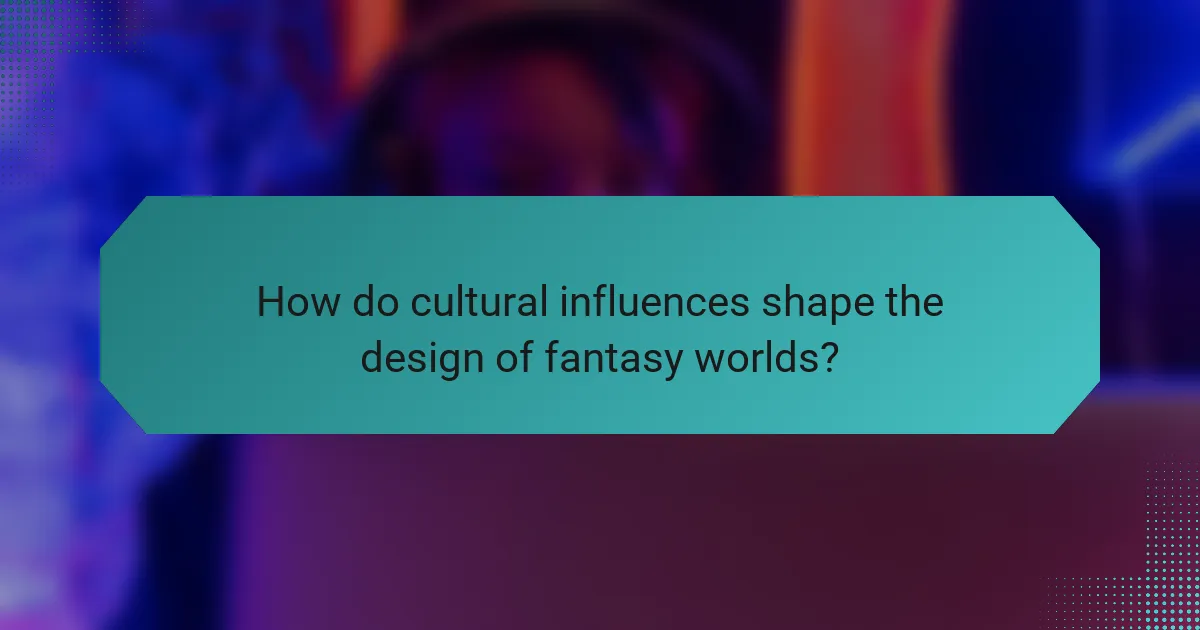Creating dynamic worlds in indie fantasy adventure games enhances player engagement and immersion. Key techniques include procedural generation for diverse landscapes, player agency that shapes narratives, and deep lore that enriches storytelling. Successful examples like “Hollow Knight” and “Disco Elysium” showcase innovative design and cultural influences. Developers face challenges in balancing player freedom with narrative coherence while leveraging tools for effective world-building.

What are the key elements of dynamic world-building in indie fantasy adventure games?
Dynamic world-building in indie fantasy adventure games involves creating immersive environments that respond to player actions. Key elements include procedural generation, player agency, and narrative depth.
Procedural generation allows for diverse landscapes and quests, enhancing replayability. Player agency empowers users to shape the world through choices, affecting story outcomes and character interactions. Narrative depth adds layers through lore, character backstories, and meaningful quests, making the world feel alive.
Incorporating these elements fosters a rich, engaging experience that captivates players, encouraging exploration and emotional investment.
How do narrative and lore contribute to immersive environments?
Narrative and lore significantly enhance immersive environments by providing depth and context. They create emotional connections, making players feel invested in the story and world. Rich backstories and character development foster engagement, while environmental storytelling reinforces the game’s atmosphere. This interplay between narrative and gameplay mechanics contributes to a cohesive and captivating experience.
What role does player agency play in shaping game worlds?
Player agency significantly shapes game worlds by allowing players to influence narratives and environments. This interactivity fosters immersion, enabling players to make meaningful choices that affect outcomes. Techniques such as branching storylines and dynamic NPC interactions highlight player decisions, enhancing engagement. Tools like narrative design software and game engines facilitate this complexity, empowering developers to create responsive worlds. Examples include games like “Undertale,” where choices directly impact the story and gameplay, illustrating the power of player agency in crafting unique experiences.
Which design principles enhance the exploration experience?
Design principles that enhance the exploration experience include environmental storytelling, player agency, and dynamic world-building. These elements create immersive and engaging gameplay, allowing players to discover narratives organically.
Environmental storytelling uses visuals and design to convey lore, encouraging players to explore their surroundings. Player agency empowers individuals to make choices that impact the game world, fostering a sense of ownership. Dynamic world-building involves creating adaptable environments that respond to player actions, enhancing immersion and exploration.

What techniques are commonly used to create engaging game worlds?
Engaging game worlds in indie fantasy adventure games are often created using techniques like procedural generation, immersive storytelling, and dynamic environments. These methods enhance player experience by creating unique, interactive spaces.
Procedural generation allows developers to create vast, varied landscapes efficiently, ensuring no two playthroughs are the same. Immersive storytelling integrates character backstories and quests into the environment, making players feel connected to the world. Dynamic environments, which change based on player actions, add depth and realism, encouraging exploration and interaction.
Examples of these techniques can be seen in games like “Hollow Knight,” which utilizes intricate level design and lore, and “Stardew Valley,” which features evolving landscapes and seasonal changes. These elements collectively contribute to a captivating gaming experience.
How does procedural generation impact world diversity?
Procedural generation significantly enhances world diversity by creating unique environments, quests, and characters dynamically. This technique allows indie fantasy adventure games to offer varied experiences with each playthrough, engaging players through unpredictable challenges. For example, algorithms can generate landscapes, dungeons, and NPC interactions, ensuring no two gaming sessions feel the same. The unique attribute of procedural generation lies in its ability to adapt based on player choices, further enriching the immersive experience.
What are the benefits of handcrafted environments versus procedurally generated ones?
Handcrafted environments offer unique benefits over procedurally generated ones in indie fantasy adventure games. They provide a distinct narrative depth and emotional connection through intentional design.
Handcrafted worlds allow for intricate storytelling, as developers can embed lore and character arcs into the environment. This results in a more immersive experience for players. The attention to detail in handcrafted settings enhances visual aesthetics, creating memorable landscapes that players can explore.
In contrast, procedurally generated environments often lack this level of personalization. While they can offer vast and varied landscapes, they may not evoke the same emotional resonance. The unpredictability of procedural generation can lead to repetitive or disjointed experiences, which may detract from player engagement.
Ultimately, the choice between handcrafted and procedurally generated environments hinges on the desired player experience. Handcrafted worlds excel in narrative and emotional engagement, while procedural generation offers scalability and diversity.
Which tools are most effective for indie developers in world-building?
Game engines like Unity and Unreal Engine are highly effective for indie developers in world-building. These tools offer extensive asset libraries, powerful rendering capabilities, and user-friendly interfaces. Additionally, tools like Tiled and World Machine facilitate level design and terrain generation, enhancing the creative process. Collaboration platforms such as Trello or Notion can help organize ideas and track progress, ensuring a cohesive development workflow.

How do cultural influences shape the design of fantasy worlds?
Cultural influences significantly shape the design of fantasy worlds by informing themes, aesthetics, and narrative structures. Designers draw from mythology, folklore, and historical contexts to create immersive environments. For example, Asian cultures often inspire intricate architecture and spiritual elements, while Western influences may emphasize chivalric themes and epic quests. These cultural layers enrich storytelling, making worlds more relatable and engaging for players. Additionally, unique cultural traits, such as specific rituals or societal norms, can differentiate one fantasy world from another, enhancing player experience and immersion.
What are some examples of regional folklore integrated into game worlds?
Regional folklore enriches game worlds by incorporating unique myths, legends, and cultural narratives. For example, “The Legend of Zelda: Breath of the Wild” integrates Japanese folklore through its design and storytelling. “Spiritfarer” draws on various cultural beliefs about the afterlife, reflecting diverse traditions. “Never Alone” showcases Inuit stories and perspectives, enhancing player immersion. “The Witcher 3” weaves Slavic folklore into its quests and character designs. Each game utilizes these regional tales to create authentic and engaging experiences.
How can developers respectfully incorporate diverse cultural elements?
Developers can respectfully incorporate diverse cultural elements by engaging with communities and conducting thorough research. This approach fosters authenticity and avoids stereotypes.
Collaboration with cultural consultants ensures accurate representation. Additionally, developers should prioritize inclusivity in design and storytelling. Using diverse narratives enhances player experience and promotes cultural appreciation.
Implementing these practices creates immersive worlds that resonate with a broader audience while honoring the cultures represented.

What unique attributes set successful indie fantasy adventure games apart?
Unique attributes that set successful indie fantasy adventure games apart include innovative storytelling, immersive world-building, and player-driven choices. These games often utilize unique art styles and experimental gameplay mechanics to engage players. Additionally, strong community involvement and feedback loops enhance the development process, allowing for tailored experiences that resonate with audiences. By focusing on these distinctive traits, indie developers create memorable and dynamic gaming environments that stand out in a crowded market.
How do innovative gameplay mechanics enhance world interaction?
Innovative gameplay mechanics significantly enhance world interaction by creating immersive experiences. These mechanics allow players to engage with environments dynamically, influencing the narrative and gameplay outcomes. For instance, crafting systems enable players to manipulate resources, fostering creativity and personal investment in the game world. Unique attributes, like destructible environments, add realism and depth, encouraging exploration and experimentation. As a result, players feel a stronger connection to the game, enhancing overall enjoyment and replayability.
What storytelling techniques differentiate standout titles?
Standout titles in indie fantasy adventure games utilize immersive world-building, character development, and innovative narrative structures. Techniques such as nonlinear storytelling, rich lore integration, and player-driven choices enhance engagement. Tools like dynamic dialogue systems and environmental storytelling create depth. Examples include “Hollow Knight” for its atmospheric world and “Undertale” for its unique character interactions.

What are the common challenges faced in crafting dynamic worlds?
Common challenges in crafting dynamic worlds include balancing player freedom with narrative structure, ensuring consistent lore, and managing resource constraints. Developers often struggle with creating immersive environments that feel alive while maintaining gameplay mechanics. Additionally, integrating player choices without disrupting the overall story can be complex. Limited budgets and time can hinder the depth of world-building, impacting the richness of the experience.
How can developers overcome resource limitations?
Developers can overcome resource limitations by leveraging efficient tools and techniques. Utilizing modular design allows for the reuse of assets, reducing development time and costs. Open-source engines like Godot or Unity provide powerful features without hefty licensing fees. Collaborating with a community can also yield shared resources and knowledge, enhancing creativity and problem-solving. Prioritizing essential game mechanics ensures focus on core gameplay, maximizing impact with limited resources.
What strategies help maintain player engagement over time?
Engaging players over time in indie fantasy adventure games requires dynamic world-building and interactive elements. Incorporating evolving narratives, player-driven choices, and regular content updates enhances immersion. Unique attributes like personalized quests and community-driven events foster ongoing interest. Additionally, utilizing feedback loops can refine gameplay, ensuring player satisfaction and retention.

Which recent examples exemplify successful dynamic world-building?
Recent successful dynamic world-building examples in indie fantasy adventure games include “Disco Elysium,” “Hollow Knight,” and “Celeste.” These games effectively create immersive environments through rich storytelling, unique art styles, and interactive gameplay. “Disco Elysium” features a complex narrative influenced by player choices, while “Hollow Knight” showcases interconnected areas that reveal lore through exploration. “Celeste” emphasizes emotional depth, using its world to reflect character struggles. Each game exemplifies innovative techniques in crafting engaging and dynamic worlds.
What can be learned from critically acclaimed indie titles?
Critically acclaimed indie titles showcase innovative world-building techniques that enhance player immersion. These games often utilize unique art styles, dynamic narratives, and player-driven choices to create engaging experiences. For instance, “Hollow Knight” employs intricate lore and interconnected environments, while “Celeste” focuses on emotional storytelling through gameplay mechanics. Tools like Unity and Unreal Engine enable developers to craft these vibrant worlds, allowing for creative freedom. As a result, indie games often push the boundaries of traditional design, inspiring larger studios to explore new concepts.
How do player feedback and community involvement shape future updates?
Player feedback and community involvement significantly influence future updates in indie fantasy adventure games. Developers utilize player insights to enhance gameplay, balance mechanics, and introduce new features. This iterative process fosters a dynamic gaming environment, aligning updates with player desires. Community engagement also builds loyalty, encouraging players to contribute ideas and report issues, further shaping game evolution.
What are the emerging trends in indie game world-building for 2025?
Emerging trends in indie game world-building for 2025 focus on immersive storytelling, procedurally generated environments, and community-driven content. Developers increasingly utilize advanced tools like Unreal Engine and Unity for dynamic landscapes. Innovations in AI enhance NPC interactions, creating more engaging experiences. Additionally, sustainability in design is gaining traction, with developers prioritizing eco-friendly practices.

What best practices should developers follow for effective world-building?
Developers should prioritize immersion, coherence, and interactivity for effective world-building. Focus on creating a rich lore that enhances player engagement. Use tools like world-building software to visualize environments and character arcs. Incorporate player choices to influence the narrative, making the world feel alive. Regularly test and iterate based on player feedback to refine the experience.
How can iterative design improve world dynamics?
Iterative design enhances world dynamics in indie fantasy adventure games by fostering continuous improvement and player engagement. This approach allows developers to refine game mechanics, storytelling, and environments based on user feedback. As a result, worlds become more immersive and responsive to player actions. Iterative design also enables the incorporation of diverse player perspectives, enriching the overall experience. Ultimately, this process leads to dynamic worlds that evolve, adapt, and resonate more deeply with players.
What common mistakes should be avoided in the development process?
Avoiding common mistakes in the development process is crucial for crafting engaging indie fantasy adventure games. Key mistakes include neglecting player feedback, underestimating scope, and failing to prototype effectively.
1. Ignoring player feedback can result in a disconnect between the game and its audience. Regular playtests help refine mechanics and narrative.
2. Underestimating scope leads to burnout and incomplete projects. Set realistic goals and prioritize features.
3. Skipping prototyping can hinder creativity. Early prototypes allow for experimentation and iteration, enhancing gameplay dynamics.
4. Overlooking narrative coherence can diminish immersion. Ensure that the story aligns with gameplay and world-building.
5. Failing to document processes can complicate collaboration. Maintain clear documentation for team members and future reference.
Which resources are recommended for aspiring indie developers?
Aspiring indie developers should explore online resources, tutorials, and communities focused on game design. Recommended platforms include Unity Learn for development techniques, Gamasutra for industry insights, and Reddit’s indie game subreddits for peer support. Additionally, books like “The Art of Game Design” provide foundational knowledge on crafting engaging experiences.